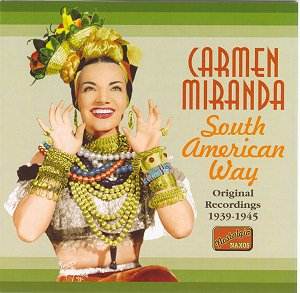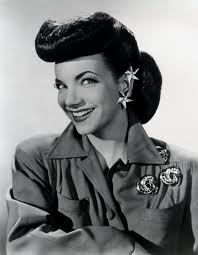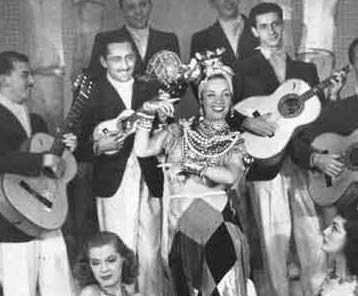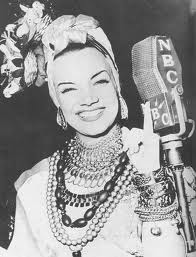 Carmen Miranda 9 February 1909 – 5 August 1955) was a Portuguese-born Brazilian[1] samba singer and Broadway actress popular in the 1940s and 1950s. She was, by some accounts, the highest-earning woman in the United States and recognized for her signature fruit hat outfit that she wore in the 1943 movie The Gang’s All Here. She is considered the precursor of Brazil‘s Tropicalismo.
Carmen Miranda 9 February 1909 – 5 August 1955) was a Portuguese-born Brazilian[1] samba singer and Broadway actress popular in the 1940s and 1950s. She was, by some accounts, the highest-earning woman in the United States and recognized for her signature fruit hat outfit that she wore in the 1943 movie The Gang’s All Here. She is considered the precursor of Brazil‘s Tropicalismo.
Carmen Miranda was born in Várzea da Ovelha, a village in the northern Portuguese municipality of Marco de Canaveses.[1] She was the second daughter of José Maria Pinto Cunha (1887 – 1938) and Maria Emília Miranda (1886 – 1971).[2] When she was 10-months old, her father emigrated to Brazil[3] and settled in Rio de Janeiro, where he opened a barber’s shop. Her mother followed in 1910, together with her daughters Olinda and Maria do Carmo. Maria do Carmo never returned to Portugal, but retained her Portuguese nationality. In Brazil, her parents had four more children – Amaro (1911), Cecília (1913), Aurora (1915 – 2005) and Óscar (1916).[2]
 She was christened Carmen by her father because of his love for the opera comique, and also after Bizet‘s masterpiece Carmen. This passion for opera influenced his children, and Miranda’s love for singing and dancing at an early age.[3] She went to school at the Convent of Saint Therese of Lisieux. Her father did not approve of her plans to enter show business. However, her mother supported her and was beaten when her husband discovered Carmen had auditioned for a radio show. Carmen had previously sung at parties and festivals in Rio. Her older sister Olinda contracted tuberculosis and was sent to Portugal for treatment. Miranda went to work in a tie shop at age 14 to help pay her sister’s medical bills. She next worked in a boutique, where she learned to make hats and opened her own hat business which became profitable.
She was christened Carmen by her father because of his love for the opera comique, and also after Bizet‘s masterpiece Carmen. This passion for opera influenced his children, and Miranda’s love for singing and dancing at an early age.[3] She went to school at the Convent of Saint Therese of Lisieux. Her father did not approve of her plans to enter show business. However, her mother supported her and was beaten when her husband discovered Carmen had auditioned for a radio show. Carmen had previously sung at parties and festivals in Rio. Her older sister Olinda contracted tuberculosis and was sent to Portugal for treatment. Miranda went to work in a tie shop at age 14 to help pay her sister’s medical bills. She next worked in a boutique, where she learned to make hats and opened her own hat business which became profitable.
“Chica Chica Boom Chic
Her extraordinary talent was discovered when Miranda was first introduced to composer Josué de Barros, who went on to promote and record her first album with a Brunswick, a German recording company in 1929. In 1930, she was known to be Brazil’s gem singer, and in 1933 went on to sign a two-year contract with Rádio Mayrink Veiga – becoming the first contract singer in the radio industry history of Brazil. In 1934, she was invited as a guest performer in Radio Belgrano in Buenos Aires.[3] Ultimately, Miranda wound up with a recording contract with RCA Records. She pursued a career as a samba singer for ten years before she was invited to New York City to perform in a show on Broadway. As with other popular singers of the era, Miranda made her screen debut in the Brazilian documentary A Voz Do Carnaval (1933). Two years later, Miranda appeared in her first feature film entitled Alô, Alô Brasil. But it was the 1935 film Estudantes that seemed to solidify her in the minds of the movie-going public. In the 1936 movie Alô Alô Carnaval, she performed the famous song Cantoras do Rádio with her sister Aurora, for the first time.[3]
Barros, who went on to promote and record her first album with a Brunswick, a German recording company in 1929. In 1930, she was known to be Brazil’s gem singer, and in 1933 went on to sign a two-year contract with Rádio Mayrink Veiga – becoming the first contract singer in the radio industry history of Brazil. In 1934, she was invited as a guest performer in Radio Belgrano in Buenos Aires.[3] Ultimately, Miranda wound up with a recording contract with RCA Records. She pursued a career as a samba singer for ten years before she was invited to New York City to perform in a show on Broadway. As with other popular singers of the era, Miranda made her screen debut in the Brazilian documentary A Voz Do Carnaval (1933). Two years later, Miranda appeared in her first feature film entitled Alô, Alô Brasil. But it was the 1935 film Estudantes that seemed to solidify her in the minds of the movie-going public. In the 1936 movie Alô Alô Carnaval, she performed the famous song Cantoras do Rádio with her sister Aurora, for the first time.[3]
Mamae Eu Quiero
Miranda signed a movie contract with Hollywood and arrived in the United States in 4 May 1939[3] with her band, the Bando da Lua. Carmen grew to fame in the country quickly, having formally been presented to President Franklin D. Roosevelt at a White House banquet shortly after arrival, and going on to star in 13 Hollywood films.[3] She was encouraged by the United States government as part of President Roosevelt’s Good Neighbor Policy, designed to strengthen links with Latin America and Europe; it was believed that in delivering content like hers, the policy would be better received by the American public. By 1946 she was Hollywood‘s highest-paid entertainer and top female tax payer in the United States,[3] earning more than $200,000 that year, according to IRS records.
with her band, the Bando da Lua. Carmen grew to fame in the country quickly, having formally been presented to President Franklin D. Roosevelt at a White House banquet shortly after arrival, and going on to star in 13 Hollywood films.[3] She was encouraged by the United States government as part of President Roosevelt’s Good Neighbor Policy, designed to strengthen links with Latin America and Europe; it was believed that in delivering content like hers, the policy would be better received by the American public. By 1946 she was Hollywood‘s highest-paid entertainer and top female tax payer in the United States,[3] earning more than $200,000 that year, according to IRS records.
 Against her family’s wishes, she married in March 17, 1947 to failed American movie producer David Sebastian. He soon declared himself to be her “manager” and was responsible for many bad business deals. A heavy drinker, he got Miranda into drinking as well and is accused of eventually being her downfall. In 1948 she became pregnant, but suffered a miscarriage after a show. The marriage lasted only a few months, but Carmen, who was Catholic, would not accept getting a divorce. Her sister Aurora later would state in the documentary Bananas is My Business that “he was very rude, many times even hit her. The marriage was a burden in her life; he only married her for her money. He did not like our family”.
Against her family’s wishes, she married in March 17, 1947 to failed American movie producer David Sebastian. He soon declared himself to be her “manager” and was responsible for many bad business deals. A heavy drinker, he got Miranda into drinking as well and is accused of eventually being her downfall. In 1948 she became pregnant, but suffered a miscarriage after a show. The marriage lasted only a few months, but Carmen, who was Catholic, would not accept getting a divorce. Her sister Aurora later would state in the documentary Bananas is My Business that “he was very rude, many times even hit her. The marriage was a burden in her life; he only married her for her money. He did not like our family”.
“Chattanooga Choo Choo” In Portuguese!!
Miranda made a total of fourteen Hollywood films between 1940 and 1953 and was dubbed “The Brazilian Bombshell”.[4] Her Hollywood image was one of a generic Latinness that blurred the distinctions between Brazil, Portugal, Argentina, and Mexico as well as between samba, tango and habanera. It was carefully stylized and outlandishly flamboyant. She was often shown wearing platform sandals and towering headdresses made of fruit, becoming famous as “the lady in the tutti-frutti hat.”[5] However there were times that Miranda performed barefoot on stage because she could move more easily in bare feet than in the towering platform sandals.
“When I Love I Love”
During a visit to Brazil in 1940, Miranda was heavily criticized for giving in to American commercialism and projecting a false image of Brazil. She responded with the Portuguese language song “Disseram que Voltei Americanizada“, or “They Say I’ve Come Back Americanized.” Another song, “Bananas is My Business,” was based on a line in one of her movies and directly addressed her image. She was greatly upset by the criticism and did not return to Brazil again for fourteen years.
After returning to the United States, Miranda made her final film appearance in the 1953 film Scared Stiff with Martin and Lewis.[6]
In the later years of her life, in addition to her already heavy smoking and alcohol consumption, Miranda began taking amphetamines and barbiturates, all of which took a toll on her body.[7]
 On August 4, 1955, Miranda suffered a heart attack during a segment of the live TV show The Jimmy Durante Show, although she did not realize it. After completing a dance number (which was later aired on A&E Network‘s Biography episode about Miranda), she fell to her knees, and Durante instinctively told the band to “stop da music!”. He helped Miranda up to her feet as she laughed “I’m all out of breath!”. “Dat’s OK, honey, I’ll take yer lines”, Durante replied. Miranda laughed again and quickly pulled herself together, finishing the show. At the end of the broadcast, she smiled and waved, then exited the stage. She died later that night after suffering a second heart attack at her home in Beverly Hills.[8]
On August 4, 1955, Miranda suffered a heart attack during a segment of the live TV show The Jimmy Durante Show, although she did not realize it. After completing a dance number (which was later aired on A&E Network‘s Biography episode about Miranda), she fell to her knees, and Durante instinctively told the band to “stop da music!”. He helped Miranda up to her feet as she laughed “I’m all out of breath!”. “Dat’s OK, honey, I’ll take yer lines”, Durante replied. Miranda laughed again and quickly pulled herself together, finishing the show. At the end of the broadcast, she smiled and waved, then exited the stage. She died later that night after suffering a second heart attack at her home in Beverly Hills.[8]
Her last performance
In accordance with her wishes, Miranda’s body was flown back to Rio de Janeiro where the Brazilian government declared a period of national mourning.[9] 60,000 people attended her mourning ceremony at the Rio town hall[3], and more than a half a million Brazilians escorted the funeral cortège to her resting place.[10] She is buried in the Cemitério São João Batista in Rio de Janeiro.[11]
For her contribution to the motion picture industry, Carmen Miranda has a star on the Hollywood Walk of Fame at 6262 Hollywood Boulevard.
In his third album, Tropicalia, Caetano Veloso pays tribute to her in the lyrics of the titular song, “Viva a banda, -da, -da/Carmen Miranda, -da, -da, -da, -da.”
Helena Solberg made a documentary of her life, Carmen Miranda: Bananas is My Business in 1995.
Miranda’s enormous, fruit-laden hats are iconic visuals recognized around the world. These costumes led to Saks Fifth Avenue developing a line of turbans and jewelry inspired by Carmen Miranda in 1939. [12] Many costume jewelry designers made fruit jewelry also inspired by Carmen Miranda which is still highly valued and collectible by vintage and antique costume jewelry collectors. Fruit jewelry is still popular in jewelry design today. Much of the fruit jewelry seen today is often still fondly called “Carmen Miranda jewelry” because of this. Her image was much satirized and taken up as camp, and today, the “Carmen Miranda” persona is popular among drag performers. The style was even emulated in animated cartoon shorts. The animation department at Warner Brothers seemed to be especially fond of the actress’s image. Animator Virgil Ross used it in his short Slick Hare, featuring Bugs Bunny, who escapes from Elmer Fudd by hiding in the fruit hat. Bugsy himself mimics Miranda briefly in What’s Cookin’ Doc? Tex Avery also used it in his MGM short Magical Maestro when an opera singer is temporarily changed into the persona, fruit hat and all, via a magician’s wand.
costumes led to Saks Fifth Avenue developing a line of turbans and jewelry inspired by Carmen Miranda in 1939. [12] Many costume jewelry designers made fruit jewelry also inspired by Carmen Miranda which is still highly valued and collectible by vintage and antique costume jewelry collectors. Fruit jewelry is still popular in jewelry design today. Much of the fruit jewelry seen today is often still fondly called “Carmen Miranda jewelry” because of this. Her image was much satirized and taken up as camp, and today, the “Carmen Miranda” persona is popular among drag performers. The style was even emulated in animated cartoon shorts. The animation department at Warner Brothers seemed to be especially fond of the actress’s image. Animator Virgil Ross used it in his short Slick Hare, featuring Bugs Bunny, who escapes from Elmer Fudd by hiding in the fruit hat. Bugsy himself mimics Miranda briefly in What’s Cookin’ Doc? Tex Avery also used it in his MGM short Magical Maestro when an opera singer is temporarily changed into the persona, fruit hat and all, via a magician’s wand.
1944 “I’m Just Wild About Harry”
 Brazilian singer Ney Matogrosso‘s album Batuque brings the period and several of Miranda’s early hits back to life in faithful style. Caetano Veloso paid tribute to Miranda for her early samba recordings made in Rio when he recorded “Disseram que Voltei Americanizada” on the live album Circuladô Vivo in 1992. He also examined her iconic legacy of both kitsch and sincere samba artistry in an essay in the New York Times. Additionally, on one of Veloso’s most popular songs, “Tropicalia”, Veloso sings “Viva a banda da da da….Carmem Miranda da da da” as the final lyrics of the song. Singer/songwriter Jimmy Buffett included a tribute to Carmen Miranda on his 1973 album A White Sport Coat and a Pink Crustacean, entitled “They Don’t Dance Like Carmen No More.” In the early 1970s a novelty act known as Daddy Dewdrop had a top 10 hit single in the US titled “Chick-A-Boom,” one of Carmen’s trademark song phrases, although the resemblance ended there. The band Pink Martini recorded “Tempo perdido” for their Hey Eugene! Album on 2007.
Brazilian singer Ney Matogrosso‘s album Batuque brings the period and several of Miranda’s early hits back to life in faithful style. Caetano Veloso paid tribute to Miranda for her early samba recordings made in Rio when he recorded “Disseram que Voltei Americanizada” on the live album Circuladô Vivo in 1992. He also examined her iconic legacy of both kitsch and sincere samba artistry in an essay in the New York Times. Additionally, on one of Veloso’s most popular songs, “Tropicalia”, Veloso sings “Viva a banda da da da….Carmem Miranda da da da” as the final lyrics of the song. Singer/songwriter Jimmy Buffett included a tribute to Carmen Miranda on his 1973 album A White Sport Coat and a Pink Crustacean, entitled “They Don’t Dance Like Carmen No More.” In the early 1970s a novelty act known as Daddy Dewdrop had a top 10 hit single in the US titled “Chick-A-Boom,” one of Carmen’s trademark song phrases, although the resemblance ended there. The band Pink Martini recorded “Tempo perdido” for their Hey Eugene! Album on 2007.
Brazilian author Ruy Castro wrote a biography of Carmen Miranda entitled Carmen, published in 2005 in Brazil. This book has yet to appear in English.
Visitors to Rio de Janeiro can find a museum dedicated to Carmen Miranda in the Flamengo neighborhood on Avenida Rui Barbosa. The museum includes several original costumes, and shows clips from her filmography. There is also a museum dedicated to her in Marco de Canaveses, Portugal called “Museu Municipal Carmen Miranda”, with various photos and one of the famous hats. Outside the museum there is a statue of Carmen Miranda.
 A hot air balloon in her likeness was conceived in 1982 at the Albuquerque International Balloon Fiesta by Jacques Soukup and Kirk Thomas. Named “Chic-I-Boom”, the craft was built by Cameron England, and was the first special-shaped hot-air balloon ever to fly at the Albuquerque Balloon Fiesta. The original Chic-I-Boom was retired from flight in 1996, and a new Chic-I-Boom was built by Aerostar. Chic-I-Boom’s bananas are each 50 feet long.
A hot air balloon in her likeness was conceived in 1982 at the Albuquerque International Balloon Fiesta by Jacques Soukup and Kirk Thomas. Named “Chic-I-Boom”, the craft was built by Cameron England, and was the first special-shaped hot-air balloon ever to fly at the Albuquerque Balloon Fiesta. The original Chic-I-Boom was retired from flight in 1996, and a new Chic-I-Boom was built by Aerostar. Chic-I-Boom’s bananas are each 50 feet long.
The singer Leslie Fish created a song called “Carmen Miranda’s Ghost is Haunting Space Station Three”, in which a space station is inundated with fresh fruit. A science fiction anthology later had the same title.
John Cale, a member of the Velvet Underground, issued a song called “The Soul of Carmen Miranda” on his album Words for the Dying.
A suburb in Sydney, Australia called “Miranda” has a night club called “Carmens” thus being Carmens (in) Miranda.
Some time ago, I saw an interview with Alice Faye as the guest. Alice said that 20th Century Fox had entered into a rather boring period and they were looking to breathe some new life into the studio. Carmen Miranda burst onto the scene. Alice Faye said she was a bundle of energy and despite her “hokey” appearance and crazy costumes, she was extraordinarily talented and a very savvy business woman. She was exactly what the studio was looking for and everyone there welcomed her. No wonder Carmen Miranda quickly rose to the status of highest paid female celebrity in the country.
Sources: imdb.com, nndb.com, youtube, wikipedia
Visit our sponsor: Two Guys From Brooklyn
Quick Bio Facts:
 Carmen Miranda
Carmen Miranda
AKA Maria do Carmo Miranda Da Cunha
Born: 9-Feb–1909
Birthplace: Marco de Canavezes, Portugal
Died: 5-Aug–1955
Location of death: Beverly Hills, CA
Cause of death: Heart Failure
Remains: Buried, Cemitério São João Batista, Rio de Janeiro, Brazil
Gender: Female
Race or Ethnicity: White
Sexual orientation: Bisexual
Occupation: Dancer, Musician
Nationality: United States
Executive summary: The lady in the tutti-frutti hat
Father: José Maria Pinto da Cunha (barber)
Mother: Maria Emília Miranda da Cunha (homemaker)
Sister: Olinda (b. 1907)
Brother: Mario (b. 1911)
Sister: Cecília (b. 1913)
Sister: Aurora Miranda (actress, b. 20-Apr-1915)
Brother: Oscar (b. 1916)
Husband: David Sebastian (m. 17-Mar-1947, until her death)
Nervous Breakdown
Risk Factors: Depression
FILMOGRAPHY AS ACTOR
It’s All True (15-Oct-1993) Herself [VOICE]
Scared Stiff (27-Apr-1953)
Nancy Goes to Rio (10-Mar-1950)
A Date with Judy (21-Jun-1948)
Copacabana (1-Nov-1947)
If I’m Lucky (2-Sep-1946)
Doll Face (Jan-1946)
Something for the Boys (1-Nov-1944)
Greenwich Village (27-Sep-1944)
Four Jills in a Jeep (17-Mar-1944) Herself
The Gang’s All Here (24-Dec-1943)
Springtime in the Rockies (6-Nov-1942)
Week-End in Havana (8-Oct-1941)
That Night in Rio (11-Apr-1941)
Down Argentine Way (11-Oct-1940) Herself
Official Website:
http://www.carmenmiranda.net/
Filmography
| Film | |||
|---|---|---|---|
| Year | Film | Role | Notes |
| 1933 | A Voz do Carnaval | Herself at Rádio Mayrink Veiga | |
| 1935 | Alô, Alô, Brasil | ||
| Estudantes | Mimi | ||
| 1936 | Alô Alô Carnaval | ||
| 1939 | Banana-da-Terra | ||
| 1940 | Laranja-da-China | ||
| Down Argentine Way | Herself | ||
| 1941 | That Night in Rio | Carmen | |
| Week-End in Havana | Rosita Rivas | ||
| Meet the Stars #5: Hollywood Meets the Navy | Herself | Short subject | |
| 1942 | Springtime in the Rockies | Rosita Murphy | |
| 1943 | The Gang’s All Here | Dorita | Alternative title: The Girls He Left Behind |
| 1944 | Greenwich Village | Princess Querida | |
| Something for the Boys | Chiquita Hart | ||
| Four Jills in a Jeep | Herself | ||
| 1945 | The All-Star Bond Rally | Herself (Pinup girl) | |
| 1946 | Doll Face | Chita Chula | Alternative title: Come Back to Me |
| If I’m Lucky | Michelle O’Toole | ||
| 1947 | Copacabana | Carmen Novarro/Mademoiselle Fifi | |
| 1948 | A Date with Judy | Rosita Cochellas | |
| 1950 | Nancy Goes to Rio | Marina Rodrigues | |
| 1953 | Scared Stiff | Carmelita Castinha | |
| Television | |||
| Year | Title | Role | Notes |
| 1949 | The Ed Wynn Show | Herself | 1 episode |
| 1951 | What’s My Line? | Mystery Guest | 1 episode |
| 1951-1952 | The Colgate Comedy Hour | Herself | 2 episodes |
| 1953 | Toast of the Town | Herself | 1 episode |
| 1955 | The Jimmy Durante Show | Herself | 2 episodes |
Leave a comment
No comments yet.


Leave a comment